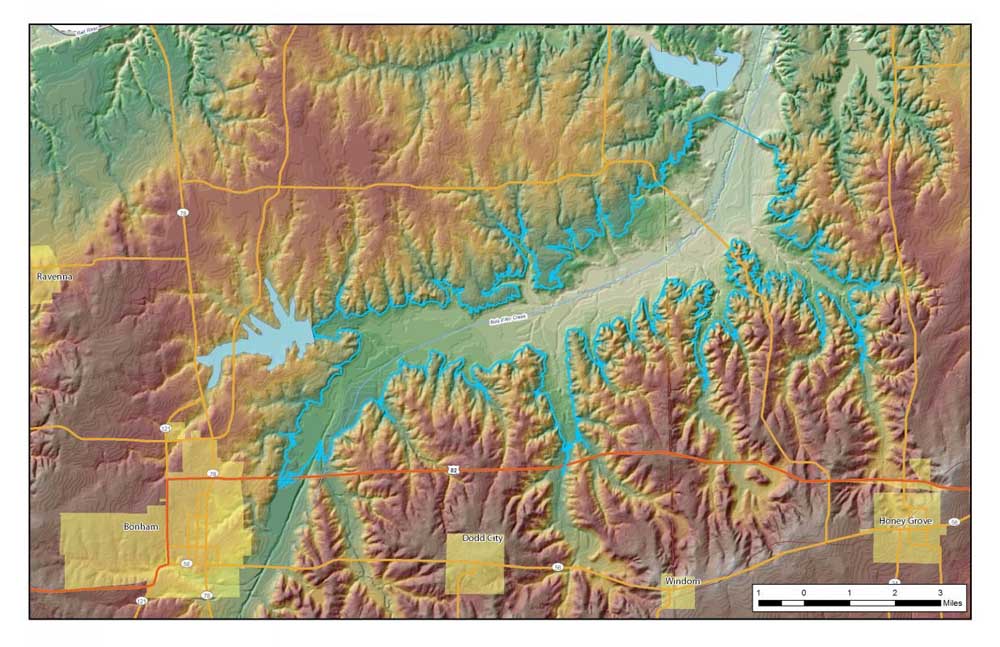Fresh Water: Texas fishermen could see first new reservoir since the 1990s
Published 12:57 am Thursday, March 1, 2018

- FREESE AND NICHOLS/COURTESYA 16,600-acre reservoir has been permitted for Fannin County. The Texas Parks and WildlifeDepartment is already working with the North Texas Municipal Water District to createfisheries for Lower Bois d’Arc Creek Reservoir.
You have to go back 18 years to find the last lake built in Texas that was over 10,000 acres in size. That was when 20,000-acre Lake O.H. Ivie was impounded on the Colorado River.
It is going to be several more years before another is built, but there is one on the drawing board that has received its final permits and is a lot closer to home. The $1 billion, 16,600-acre Lower Bois d’Arc Creek Reservoir is planned for construction in Fannin County on a tributary of the Red River. It could be open as soon as 2022, according to the North Texas Municipal Water District, which is building the lake.
Trending
Although its primary purpose is to deliver water to Dallas-area suburbs, fishermen will be looking at it in hopes it becomes the state’s next great bass fishery. To that end, Texas Parks and Wildlife Department has been working with the water district since the early days. Like with the Sabine River Authority and Lake Fork, NTMWD seems interested in cooperating.
“My predecessors, Bruce Hysmith and John Moczygemba, were actually the first fish management staff to provide comments and recommendations on NTMWD’s fisheries and boater access plans four or five years ago,” said Dan Bennett, TPWD Inland Fisheries biologist from Pottsboro.
More recently, Bennett and Inland Fisheries regional biologist Brian VanZee have met with NTMWD officials about what can be done to help fishing during the construction of the lake.
“We are happy that NTMWD has brought us into the fold early on to hear our ideas and try to incorporate many of them within the reservoir construction plan. The focus of our feedback to NTMWD was in relation to various aspects potentially impacting fishing quality, including the timber clearing plan, pre-stocking some of the existing ponds in the reservoir and potential habitat projects,” Bennett explained.
The biologist realizes that the water district’s first goal is selling water, with things like boater safety and fishing coming in a distant second. But Bennett said there is a good argument for helping develop a strong fishery in the lake.
“I don’t think anyone can discount having a new 16,000-acre fishery within an hour’s drive of over a million potential anglers in the Dallas area. I suspect the reservoir will likely result in 25- to 30-plus million dollars in angling expenditures each year, most of which is spent in the Fannin County area,” Bennett said.
Trending
At this point, Bennett is unwilling to say whether Lower Bois d’Arc is going to be the next Lake Fork as a producer of trophy bass or the next Cooper Lake, which has been a disappointment to fishermen.
“There are so many variables that come into play, it is impossible to forecast. To me, the biggest factor dictating how good a bass fishery the lake will be depends a lot on water level. If the water level remains relatively stable, with 1- to 3-foot swings in elevation, the sky is the limit. If the reservoir sees frequent periods of low water levels, that will certainly diminish the habitat available to fish and anglers’ ability to locate concentrations of bass. If we look at other nearby reservoirs like Cooper and Lavon, where lake levels occasionally drop to 10 or 12 feet below the conservation level, that latter scenario is certainly likely,” Bennett said.
With that possibility, the department has really pushed for offshore, deep-water structure to be left in the reservoir basin. There are already plans in place to leave timber standing in the lake’s upper regions and to secure and leave timber bulldozed in other areas as fish habitat. Funding for securing the down timber will come in part from TPWD fishing license plate.
Plans also call for bringing in large pieces of concrete to be put in place during construction to create habitat similar to what is more commonly done in saltwater.
Some portions of the lake will be designated as wetlands and will be planted with native aquatic vegetation to provide even more habitat for fish.
Bennett said there is a history of quality fishing in some nearby lakes, so it is not out of the question that the reservoir could become something of a trophy fishery for bass as well as crappie.
“One thing that excites me is that there are currently three fish factories in the Bois d’Arc watershed in the form of Lake Bonham, Coffee Mill and Davy Crockett. These are smaller lakes that aren’t on many anglers’ radar, but they produce some quality bass, and may be in the top 10 crappie fisheries in the state in my opinion,” Bennett said. He added Lake Bonham also produces some big catfish.
“I can’t say for certain that Lower Bois d’Arc will follow suit, but something good is certainly in the water there. We will certainly be stocking a variety of species to help establish fisheries,” he said.
Plans are already underway to follow the Lake Fork plan and pre-stock existing ponds within the lake boundaries with Florida largemouth bass. With TPWD’s emphasis on using ShareLunkers in its hatchery program, this will ensure high-quality genetics from the beginning.
Without new reservoir construction and conservation, Texas’ big cities could be facing major water problems in the coming years. Unlike the 1950s and 60s’ reservoir construction boom, this time around water authorities seem to realize to make taking land for lakes more palatable that they need to really focus on the recreational aspect from the beginning.



